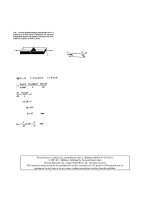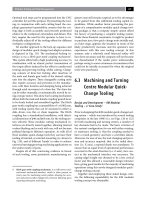Composites Manufacturing - Materials, Product, and Process Engineering Part 2 pps
Bạn đang xem bản rút gọn của tài liệu. Xem và tải ngay bản đầy đủ của tài liệu tại đây (62.23 KB, 3 trang )
© 2002 by CRC Press LLC
utilized to monitor the resin flow in an RTM (resin transfer mold-
ing) process. Materials with embedded sensors are known as
“smart” materials.
3. Composite materials have a high specific stiffness (stiffness-to-den-
sity ratio), as shown in Table 1.1. Composites offer the stiffness of
steel at one fifth the weight and equal the stiffness of aluminum at
one half the weight.
4. The specific strength (strength-to-density ratio) of a composite
material is very high. Due to this, airplanes and automobiles move
faster and with better fuel efficiency. The specific strength is typi-
cally in the range of 3 to 5 times that of steel and aluminum alloys.
Due to this higher specific stiffness and strength, composite parts
are lighter than their counterparts.
5. The fatigue strength (endurance limit) is much higher for compos-
ite materials. Steel and aluminum alloys exhibit good fatigue
strength up to about 50% of their static strength. Unidirectional
carbon/epoxy composites have good fatigue strength up to almost
90% of their static strength.
6. Composite materials offer high corrosion resistance. Iron and alu-
minum corrode in the presence of water and air and require special
coatings and alloying. Because the outer surface of composites is
formed by plastics, corrosion and chemical resistance are very good.
7. Composite materials offer increased amounts of design flexibility.
For example, the coefficient of thermal expansion (CTE) of com-
posite structures can be made zero by selecting suitable materials
and lay-up sequence. Because the CTE for composites is much
lower than for metals, composite structures provide good dimen-
sional stability.
8. Net-shape or near-net-shape parts can be produced with composite
materials. This feature eliminates several machining operations
and thus reduces process cycle time and cost.
9. Complex parts, appearance, and special contours, which are some-
times not possible with metals, can be fabricated using composite
materials without welding or riveting the separate pieces. This
increases reliability and reduces production times. It offers greater
manufacturing feasibility.
10. Composite materials offer greater feasibility for employing design
for manufacturing (DFM) and design for assembly (DFA) tech-
niques. These techniques help minimize the number of parts in a
product and thus reduce assembly and joining time. By eliminating
joints, high-strength structural parts can be manufactured at lower
cost. Cost benefit comes by reducing the assembly time and cost.
DFM and DFA techniques are discussed in Chapter 5.
© 2002 by CRC Press LLC
utilized to monitor the resin flow in an RTM (resin transfer mold-
ing) process. Materials with embedded sensors are known as
“smart” materials.
3. Composite materials have a high specific stiffness (stiffness-to-den-
sity ratio), as shown in Table 1.1. Composites offer the stiffness of
steel at one fifth the weight and equal the stiffness of aluminum at
one half the weight.
4. The specific strength (strength-to-density ratio) of a composite
material is very high. Due to this, airplanes and automobiles move
faster and with better fuel efficiency. The specific strength is typi-
cally in the range of 3 to 5 times that of steel and aluminum alloys.
Due to this higher specific stiffness and strength, composite parts
are lighter than their counterparts.
5. The fatigue strength (endurance limit) is much higher for compos-
ite materials. Steel and aluminum alloys exhibit good fatigue
strength up to about 50% of their static strength. Unidirectional
carbon/epoxy composites have good fatigue strength up to almost
90% of their static strength.
6. Composite materials offer high corrosion resistance. Iron and alu-
minum corrode in the presence of water and air and require special
coatings and alloying. Because the outer surface of composites is
formed by plastics, corrosion and chemical resistance are very good.
7. Composite materials offer increased amounts of design flexibility.
For example, the coefficient of thermal expansion (CTE) of com-
posite structures can be made zero by selecting suitable materials
and lay-up sequence. Because the CTE for composites is much
lower than for metals, composite structures provide good dimen-
sional stability.
8. Net-shape or near-net-shape parts can be produced with composite
materials. This feature eliminates several machining operations
and thus reduces process cycle time and cost.
9. Complex parts, appearance, and special contours, which are some-
times not possible with metals, can be fabricated using composite
materials without welding or riveting the separate pieces. This
increases reliability and reduces production times. It offers greater
manufacturing feasibility.
10. Composite materials offer greater feasibility for employing design
for manufacturing (DFM) and design for assembly (DFA) tech-
niques. These techniques help minimize the number of parts in a
product and thus reduce assembly and joining time. By eliminating
joints, high-strength structural parts can be manufactured at lower
cost. Cost benefit comes by reducing the assembly time and cost.
DFM and DFA techniques are discussed in Chapter 5.
© 2002 by CRC Press LLC
2
Raw Materials for Part Fabrication
2.1 Introduction
Each manufacturing method utilizes a specific type of material system for
part fabrication. One material system may be suitable for one manufacturing
method, whereas the same material system may not be suitable for another
fabrication method. For example, the injection molding process utilizes
molding compounds in pellet form, which cannot be used for filament wind-
ing or pultrusion process. Filament winding and pultrusion utilize continu-
ous fibers and wet resin systems in most cases. The roll wrapping process
requires prepreg systems for making golf club shafts, bicycle tubes, and other
products. Therefore, it is important to have a good knowledge of the various
raw materials available for the manufacture of good composite products.
Figure 2.1 depicts the various types of composite manufacturing tech-
niques and their corresponding material systems. In general, raw materials
for composite manufacturing processes can be divided into two categories:
thermoset-based and thermoplastic-based composite materials. Thermoset
plastics are those that once solidified (cured) cannot be remelted. Thermo-
plastics can be remelted and reshaped once they have solidified. Thermosets
and thermoplastics have their own advantages and disadvantages in terms
of processing, cost, recyclability, storage, and performance. In all these com-
posite systems, there are two major ingredients: reinforcements and resins.
2.2 Reinforcements
Reinforcements are important constituents of a composite material and give
all the necessary stiffness and strength to the composite. These are thin rod-
like structures. The most common reinforcements are glass, carbon, aramid
and boron fibers. Typical fiber diameters range from 5
m
m (0.0002 in.) to
20
m
m (0.0008 in.). The diameter of a glass fiber is in the range of 5 to 25
m
m,









